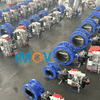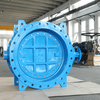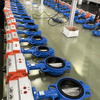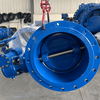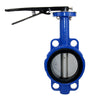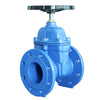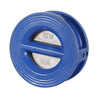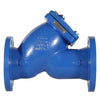How to read butterfly valve specifications for your needs
Butterfly valves are widely used across various industries due to their compact design, cost-effectiveness, and ease of operation. However, getting the most out of a butterfly valve involves more than just selecting the right diameter.
The real key lies in understanding its technical specifications—and how to interpret them.
In this article, we’ll break down the most common specifications of butterfly valves, explain what each parameter means, and offer practical tips for selecting the right valve. Whether you're an engineer or a procurement manager, this guide will help you avoid common pitfalls and make informed decisions with confidence.

Why Are Butterfly Valve Specifications Important?
While factors like size, price, and appearance are often considered during procurement, the actual performance and lifespan of a butterfly valve are heavily influenced by its specifications. For instance:
- Using a seal material incompatible with the fluid can lead to swelling and damage.
- Choosing the wrong flange standard may result in installation mismatches.
- Selecting an inappropriate pressure rating can cause leaks or even pipeline bursts.
Understanding these specifications is essential not just for interpreting datasheets but also for selecting the right product, reducing maintenance costs, and enhancing system reliability.
Key Butterfly Valve Specifications Explained
Nominal Diameter (DN/NPS)
The nominal diameter indicates the valve's size, corresponding to the pipeline's diameter. Common units include inches (NPS - Nominal Pipe Size) and millimeters (DN - Diameter Nominal), such as 2", 4", or DN100.
Purpose and Significance:
- Pipeline Compatibility: Ensures the valve matches the pipeline size, facilitating proper installation.
- Flow Control: Larger nominal diameters allow higher fluid flow rates.
Note: Be aware of differences between standards like ANSI (American) and DIN (European). Even if the nominal sizes are the same, actual dimensions may vary, leading to compatibility issues.
Pressure Rating
The pressure rating defines the maximum pressure the valve can withstand under specific temperature conditions. Different standards use varying designations:
PN (Pressure Nominal): Used in European standards (ISO/DIN), measured in bars. For example:
PN10 → 10 bar (≈1.0 MPa)
PN16 → 16 bar (≈1.6 MPa)
Class: Used in American standards (ANSI/ASME), measured in psi. For example:Class 150、
Class 300.
Selection Tip: Choose a valve with a pressure rating slightly higher than your system's maximum pressure to ensure safety.
Common Misconceptions:
- PN vs. Class: PN16 does not equate to Class 150; they have different pressure-temperature curves.
- Flange Compatibility: Even with the same nominal diameter, PN16 and Class 150 flanges may not be compatible due to differences in bolt patterns and sealing surfaces.
- Testing Requirements: Valves are typically tested at 1.5 times their pressure rating. For instance, a PN16 valve is tested at 24 bar.
Temperature Range
The operating temperature range of a butterfly valve depends on its seal and body materials. Different constructions cater to various temperature conditions:
By Seal Type:
- Soft Seals (Elastomeric): Materials like EPDM, NBR, silicone, and PTFE. Suitable for -40°C to 150°C (some PTFE up to 200°C).
- Hard Seals (Metallic): Materials like stainless steel, Stellite, and tungsten carbide. Suitable for -196°C to 600°C.
By Body Material:
|
Material |
Temperature Range (°C) |
|
Cast Iron (HT250) |
-20 to 150 |
|
Ductile Iron (QT450) |
-30 to 350 |
|
Carbon Steel (WCB) |
-29 to 425 |
|
Stainless Steel (CF8/CF8M) |
-196 to 600 |
|
Duplex Steel (2205) |
-50 to 300 |
Selection Tip: Match materials to the fluid and operating temperature. For example, seawater systems require corrosion-resistant materials like bronze or stainless steel, not cast iron.
Connection Types
The connection type affects installation, sealing performance, and suitability for specific applications:
|
Connection Type |
Features |
Applications |
|
Wafer |
No flanges; clamped between pipe flanges |
Low-pressure systems (PN10–PN16), small diameters (DN ≤ 300) |
|
Flanged |
Integrated flanges; bolted to pipe flanges |
Medium to high-pressure systems (PN16–PN40), larger diameters (DN ≥ 50) |
|
Welded |
Ends prepared for welding |
High-pressure, high-temperature, hazardous fluids |
|
Lug |
Threaded lugs for bolting |
Systems requiring downstream maintenance |

Butterfly Valve Face-to-Face Length
The face-to-face length of a butterfly valve refers to the axial distance between the two sealing or connection faces at each end of the valve body. This is a critical structural dimension for valve installation, as it determines the space the valve occupies within the pipeline system and directly affects pipeline layout and flange bolt clearance.
Different international standards define the face-to-face dimensions of butterfly valves. Common reference standards include EN 558, API 609, and others, depending on the region and application.
Actuation Methods
The actuation method of a butterfly valve determines its ease of operation, level of automation, and suitability for specific environments. Selection should be based on control requirements, environmental conditions, and budget considerations. The main types of actuation include:
- Manual lever – Suitable for small-diameter valves
- Gear (worm gear) operator – Ideal for larger diameters
- Electric actuator – Enables remote operation and automation
- Pneumatic actuator – Fast response, well-suited for automated control systems
Some butterfly valves are equipped with an ISO 5211 mounting pad, which allows for easy actuator replacement and is especially useful in automated systems.
 Flow Coefficient (Cv)
Flow Coefficient (Cv)
Interpreting a Butterfly Valve Specification Sheet?
Specification sheets typically present key parameters as follows:
|
Parameter |
Example |
|
Size |
DN100 / 4" |
|
Pressure Rating |
PN16 / Class 150 |
|
Body Material |
Ductile Iron |
|
Disc Material |
Stainless Steel 316 |
|
Seal Material |
EPDM |
|
Connection Type |
Wafer |
|
Operation Method |
Gear Operated |
Simply compare your project’s working conditions—such as pipeline size, temperature, and pressure—with the valve specifications to ensure a proper match.
Conclusion: Understanding Specifications Leads to Better Valve Selection
Butterfly valves may be compact, but selecting the right one isn’t always simple. Understanding the technical specifications is key to choosing a valve that truly fits your system—helping you avoid issues like improper installation, leakage, or premature failure.
If you still have questions about butterfly valve selection or need expert recommendations tailored to your application, feel free to contact Union Valve. Our team is here to provide you with professional support and reliable solutions.
Related Article:
- Find Your Match: Butterfly Valve Handle Types Explained
- Double Flanged vs Lug Type Butterfly Valves: Key Differences
- Functions and Features of Different Butterfly Valve Actuators
- Selection of Butterfly Valve Materials in Different Media Environments
- Step-by-Step Guide to Perfect Butterfly Valve Installation
